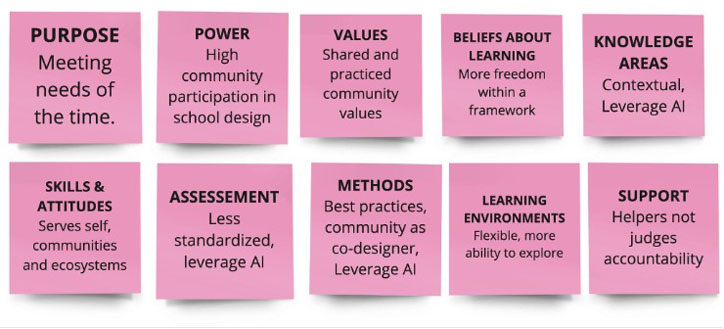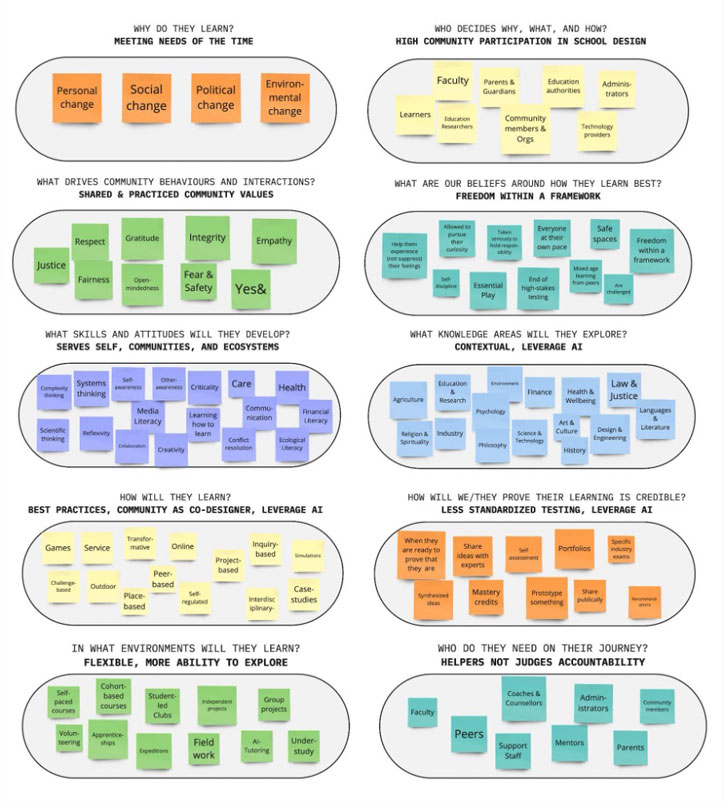
Welcome to Part Four of our series on reimagining education for an alive future. In the wake of global challenges like the COVID-19 pandemic, technological shifts with Artificial Intelligence (AI), and environmental crises like global boiling, there's a clear signal for a transformative shift in education. After laying the groundwork in earlier articles—from recognizing the need for change (Part One), dreaming up new educational landscapes (Part Two), to understanding which of these are at an inflection point to succeed (Part Three)—we move to the stage of creating and sharing a vision for an alive education.
 (Photo source: Jaya Ramchandani and Cary Reid)
(Photo source: Jaya Ramchandani and Cary Reid) Part Three left you with an activity to create a list of objectives and actions you could take to get there. Our responses below consider all future-optimistic objectives (as reimaginers, we are not tied to a particular school as an example).

(Photo source: Jaya Ramchandani and Cary Reid)
We come to our final activity of putting the vision together by answering 10 questions to flesh out details. They have been chosen to address a broad range of critical areas, from the underlying philosophies and objectives of learning to the methods, environments, and communities that shape educational experiences. Keep parts of your system that work well, delete parts that no longer serve your objectives, and include parts that will get you where you want to be. We recommend multiple iterations of this final stage with different community stakeholders.

(Photo source: Jaya Ramchandani and Cary Reid)
At the heart of this vision is the recognition of education's role in equipping individuals and communities to affect personal, social, political, and environmental change. It prioritizes high community participation in shaping learning frameworks, embedding shared values like justice, empathy, and respect at its core. We advocate for flexible, student-centered learning, and interdisciplinary and real-world approaches to foster a broad spectrum of skills and knowledge, seeing the world with all its beauty and complexity. Learning environments extend beyond the classroom, from online platforms to the great outdoors, from internships to independent projects. We promote leveraging AI with human insight to make learning relevant, engaging, and impactful, and moreover, to enable a diverse range of evaluations (self, peer, and community member) over standardized testing. This must go hand in hand with a growth in accreditation avenues for human and AI-synthesized outcomes. Lastly, we reimagine the roles of educators, parents, community members, and support staff as instructors, role models, coaches, and mentors, co-navigating in a journey of holistic, lifelong learning. This vision for education is both a challenge and a promise—a challenge to reimagine and a promise of what we might achieve when we do.
In this four-part series, we have shared a process for envisioning a future where education is alive, relevant, and transformative. If this sparks something in you, think about what education would look like in your own life or community. Two examples have inspired us recently. The first is The School of Humanity, a new international high school whose mission is to enable the next generation to create an exciting future for themselves and for humanity. They are leveraging the power of out-of-classroom, interdisciplinary learning. And the UWC Atlantic Systems Transformation Pathway, a reimagination of the International Baccalaureate Diploma Program (IBDP) to prepare students to grapple with some of the most complex global challenges confronting us in four impact areas: food, migration, biodiversity, and energy. As agents of change, we are committed to building momentum for an educational future that is vibrant, inclusive, and adaptive to the needs of our rapidly changing world. Have a look at our Miro board if you want to see more of our process for all four articles. And please reach out if you need a reimagining hand.
--------------------------------------------------------------
Jaya Ramchandani is a Liberia-born, India-raised, international educator. She worked in academic editing and publishing for a decade before entering the fascinating world of designing learning frameworks and experiences for the next decade. She is most proud of producing India’s first art-science festival, The Story of Light. Her superpower is to make sense of complex things. She has spent the last few years on the formal side of education, teaching IBDP Physics at UWC ISAK in Japan and the UN International School in New York, where she currently lives and works as an education consultant.
LinkedIn: linkedin.com/in/jayar
Cary Reid is a Jamaican educator who has spent the last decade creating alternative systems for schools so that they can support more types of students. He has tried this at high schools and universities in Jamaica, India, Hong Kong, Japan, and Norway. He has also worked on system design in public health, peacekeeping, and diplomacy.
LinkedIn: linkedin.com/in/caryreid